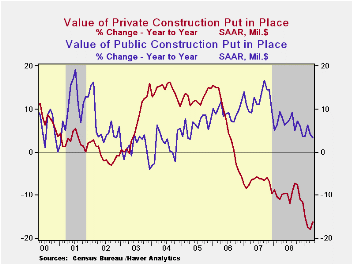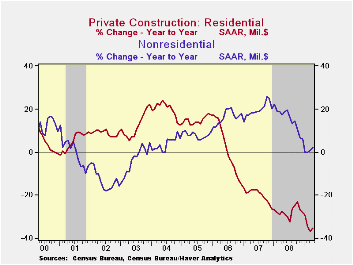 Global| Jun 01 2009
Global| Jun 01 2009U.S. Construction Spending Increases Modestly
by:Tom Moeller
|in:Economy in Brief
Summary
There's no real upward momentum driving the recent gains in construction spending, but it seems that an interim stabilization of earlier declines occurred this Spring. How long it will last is the question. For the second consecutive [...]

There's no real upward momentum driving the recent gains in construction spending, but it seems that an interim stabilization of earlier declines occurred this Spring. How long it will last is the question. For the second consecutive month the value of construction put-in-place unexpectedly rose; during April by 0.8% after a little-revised 0.4% March uptick. The gains followed declines ranging from 2% to 4% during each of the prior four months. Consensus expectations had been for a 1.6% April drop.
Another strong gain in the value of nonresidential building activity paced the April surprise. The 1.8% rise followed a 2.6% March increase. Nevertheless, the y/y gain decelerated to 2.0% following double-digit growth during each of the prior three years. Much of April's upside surprise was due to a 2.4% increase in the lodging category. Regardless, spending in this area has turned negative y/y following gains ranging between 30% and 60% during each of the prior three years. Elsewhere, office construction continued lower (-17.8% y/y) as did building in the commercial (-25.4% y/y), educational (-4.8% y/y) and amusement & recreation sectors (-18.0% y/y).
Residential building activity also bounced back by all of 0.7% during April. Nevertheless, it was still off by one-third over the last year and by two-thirds from the 2006 peak. Notably hard hit has been single-family construction activity which ticked up 0.7% after falling by three-quarters since 2006. Building activity on multi-family units fell 2.6% during April (-17.4% y/y) but spending on improvements rose 8.9% (-13.8% y/y).
In contrast to the private sector gains, public construction dipped 0.6% during April; and the recession's effect on tax revenues lowered the year-to-year growth to 3.3% from its 2007 peak of 18.6%. The value of spending on transportation facilities fell 4.6% year-to-year while spending on highways & streets inched up just 0.2% y/y. The value of construction on highways & streets is roughly one-third of the value of total public construction spending.
During the last twenty years there has been an 84% correlation between the q/q change in the value of residential building and its contribution to growth in real GDP.
The more detailed categories of construction represent the Census Bureau’s reclassification of construction activity into end-use groups. Finer detail is available for many of the categories; for instance, commercial construction is shown for automotive sales and parking facilities, drugstores, building supply stores, and both commercial warehouses and mini-storage facilities. Note that start dates vary for some seasonally adjusted line items in 2000 and 2002, and that constant-dollar data are no longer computed.
The construction put-in-place figures are available in Haver's USECON database.
Making affordable housing greener from the Federal Reserve Bank of Boston can be found here.
| Construction (%) | April | March | Y/Y | 2008 | 2007 | 2006 |
|---|---|---|---|---|---|---|
| Total | 0.8 | 0.4 | -10.7 | -5.7 | -2.7 | 6.3 |
| Private | 1.4 | 0.2 | -16.1 | -9.8 | -6.9 | 5.5 |
| Residential | 0.7 | -3.6 | -35.0 | -27.7 | -19.8 | 1.0 |
| Nonresidential | 1.8 | 2.6 | 2.0 | 14.9 | 19.6 | 16.2 |
| Public | -0.6 | 1.0 | 3.3 | 6.7 | 12.3 | 9.3 |
Tom Moeller
AuthorMore in Author Profile »Prior to joining Haver Analytics in 2000, Mr. Moeller worked as the Economist at Chancellor Capital Management from 1985 to 1999. There, he developed comprehensive economic forecasts and interpreted economic data for equity and fixed income portfolio managers. Also at Chancellor, Mr. Moeller worked as an equity analyst and was responsible for researching and rating companies in the economically sensitive automobile and housing industries for investment in Chancellor’s equity portfolio. Prior to joining Chancellor, Mr. Moeller was an Economist at Citibank from 1979 to 1984. He also analyzed pricing behavior in the metals industry for the Council on Wage and Price Stability in Washington, D.C. In 1999, Mr. Moeller received the award for most accurate forecast from the Forecasters' Club of New York. From 1990 to 1992 he was President of the New York Association for Business Economists. Mr. Moeller earned an M.B.A. in Finance from Fordham University, where he graduated in 1987. He holds a Bachelor of Arts in Economics from George Washington University.






